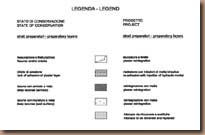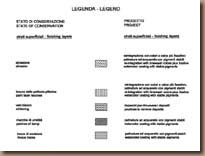State of conservation
On the internal sides of the corridors there are generally widespread surface deposits and black crusts, detachments, and losses of intonaco and color. In particular, it must be noted that the south and east walls are the most damaged. The former, up to a height of 1.50 m from the ground, has deep lacunae, losses of intonaco and color and patches of cement repairs. Rising damp has reached the maximum level, exceeding the impost of the vault; in the three niches for lighting there are serious losses of rendering, intonaco and disintegration of the constituent wall materials. The south half of the east wall has in recent years been stripped of its intonaco, with no consideration for the aesthetic result. Many deep tracks and repairs to the wall structure with cement mortar are visible, and these have seriously damaged the 12th century brick curtain-wall.
The floral decoration in the north-west corner has badly deteriorated. It is difficult to understand whether the poor state of the pigments are due to an inexpert removal of the patina finish or to original poor workmanship. Alteration of the lead white is evident.
The presence of nails and iron clamps used to attach the majority of the archaeological fragments to the walls has caused appreciable damage to the masonry structure, the intonaco and the fragments themselves. The latter are often attached with a gypsum based mortar and this has led to lack of cohesion from a mechanical, physical and chemical point of view.
The intonaco of the base structure below the coupled columns is seriously affected by rising damp with cracks and detachments on the upper parts; there are numerous repairs in the wall structure above the small arches.
The intonaco of the vaults on the whole, is well conserved. Cracking is evident in certain points due to static problems. Only on the east side have there been losses of the paint layer, as a result of its lack of adhesion to the support, which is here covered by a thick deposit of soot particles. Where the intonaco has been replaced due to the installation of electric circuits, there is a change in color. Similar phenomena are evident on the external surfaces, as well as loss of color due to rainwater washing.
|
© 1999 Coordination
Monica Morbidelli |



